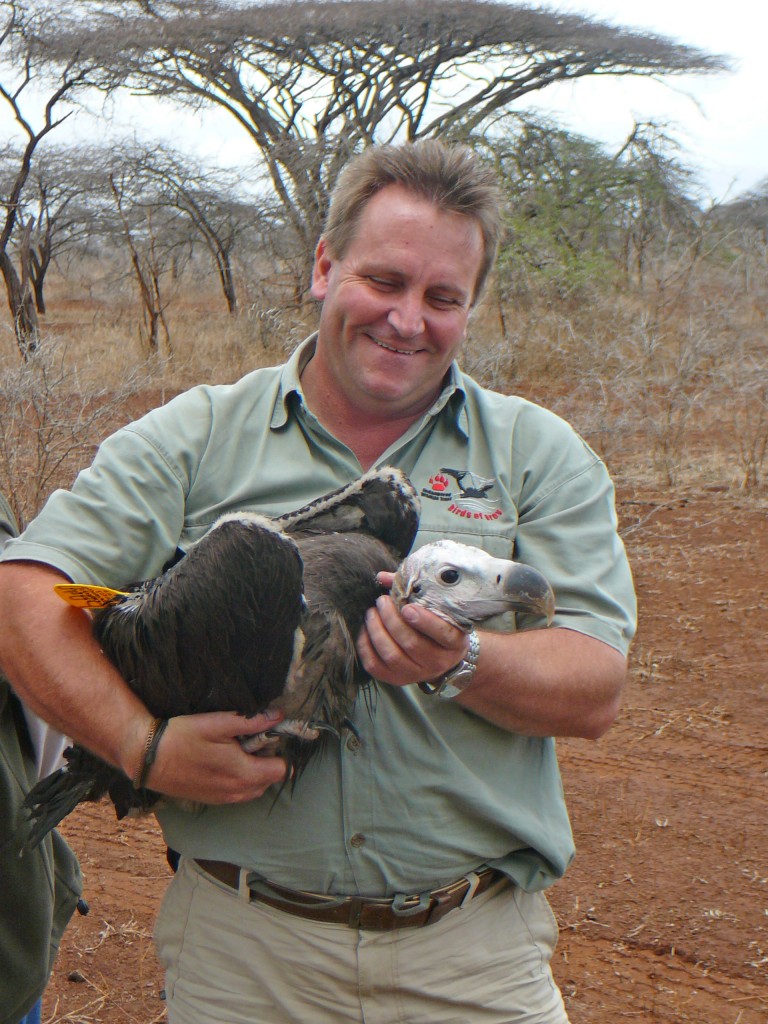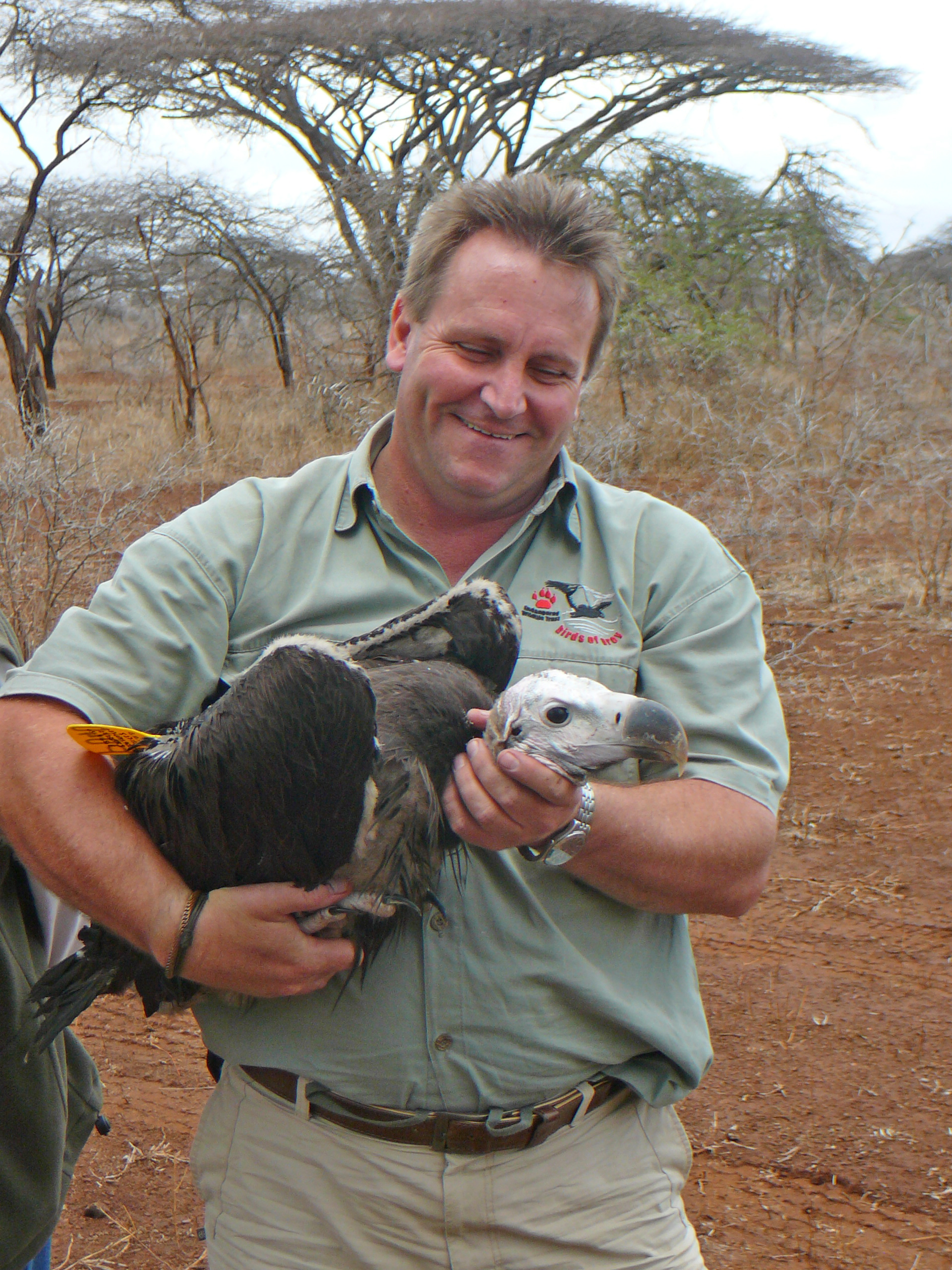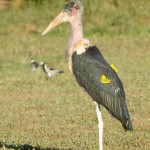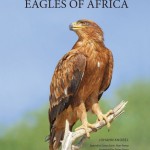Interview with Chris Bowden and André Botha about vultures in Asia and Africa and the IUCN Vulture specialist group
1) Where do you work and what do you do with vultures?
Chris: I am based at RSPB Headquarters in Sandy, England, although shifting later this year to live in Bangalore, India, but still working for RSPB with the same remit. My role is channelling RSPB support and wider coordination of efforts to conserve the critically endangered Gyps vulture species in South Asia, primarily in India but also in Nepal and the region.
Andre: I work for the Endangered Wildlife Trust in OSuth Africa as the Manager of the Birds of Prey Programme and am the Co-chair of the IUCN SSC Vulture Specialist Group.
2) You are co-chair of the IUCN vulture specialist group. What exactly is the Vulture SG and what does it do?
Chris: This is a newly established umbrella and I share responsibility with my co-chair Andre Botha who is in South Africa. Between us the main priority is to ensure there is a meaningful network and ownership of the real threats that vultures are facing globally, but with a strong emphasis on Asia and Africa where the threats are currently most apparent. Because of the recently established SAVE (Saving Asia’s Vultures from Extinction) consortium www.save-vultures.org (do have a look at what we are doing) for Asia, the VSG has a greater role to play for Africa where no such network exists, but where threats are also increasing. An early issue to tackle is ensuring that the threats are sufficiently clearly identified before putting full force behind implementing the activities required to address those threats. At least in Asia, the main threat is very clear, ie diclofenac, and most of my time is spent directly or indirectly addressing the actions needed to counter this threat. The Vulture SG does also have a wider and global remit in reviewing the red data book status of all 23 vulture species, and may also have a greater role to play in future outside Africa and Asia as it develops. Meanwhile it is a network and a framework that communicates with its members every few months, but we plan to develop a web presence and a stronger presence more widely in future.
3) You have been involved in raptor conservation in India after the dramatic decline of several gyps vultures there. How is the current situation in India and neighbouring countries?

Chris: Having been so close to the issue now for over nine years, it was just last year that I feel we really turned a corner for these species. Having at least halved the diclofenac use by vets, the real sign of progress was the 2011 surveys (India and Nepal) which showed that the declines for all 3 Critical Gyps species have significantly slowed. Similar figures also came through from Pakistan at the same time. The ongoing problems are that despite the legislation, human diclofenac is still being (illegally) used by vets, and the packaging is too convenient. I’m determined that we can stop this. The other issue is other NSAIDs coming on to the market as replacement drugs which may also be unsafe (and we know some are!).
4) Is diclofenac also a problem for non gyps species?
Chris: There has been testing of Turkey vultures (obviously a distant relative) and this proved not to be susceptible. Meanwhile we dont have evidence either way for several other key species so we simply don’t know the answer. This is some more information on this which should be published very soon I hope which unfortunately does suggest that some non-Gyps species may be susceptible… and we have confirmation that five of the Gyps species definitely are highly susceptible and worryingly that other NSAIDs that may replace diclofenac eg ketoprofen are also dangerous to them..
5) Are there alternatives for diclofenac available?
Chris: There are several alternatives, but only one so far that we know to be safe for the vultures – ie meloxicam. Others coming into the market are at least in some cases also unsafe so this is a major worry which we are also working to address.
6) What are the ecological consequences of the dramatic vulture decline and how does this affect humans?
Chris: There are multiple consequences, as we all know the role of vultures in disposing of rotting carcasses. A conservative estimate is 10,000 tonnes/year of meat is no longer consumed by the vultures that have already gone! Feral dog populations have certainly increased significantly as one consequence, and are the main vector for rabies. Anthrax has almost certainly also increased, but the main consequence is the issues surrounding having more rotting meat and the environmental pollution of water sources, the smell and other hygiene-related issues. There have been some studies of the economic impact and there are plans to do more on this, but unfortunately it has so far proved very difficult to get a full clear picture of the impacts that is fully scientifically robust, but that certainly doesn’t mean that these impacts are anything other than enormous.
8) Can something like in India also happen in Africa?
Chris: Diclofenac has appeared in the veterinary market in Africa which is very worrying and something that needs constant vigilance in all African countries to prevent it taking off on a wider scale. Having said this, it may not have quite the same scale of impact due to the lower dependence of African vultures on domestic livestock, but we can’t be complacent on this since even in countries where meat is widely consumed compared to India, the declines of vultures due to diclofenac use have been dramatically quick (I’m thinking particularly of Pakistan).
9) What is the overall situation of vultures in Africa? Which species are the most threatened and are the species that are doing well?
André: The situation in Africa is rather dire and there are some conservationists that consider the rate of decline in vulture populations in some parts of Africa comparable to that of Asia in the last decade. Three species, the African White-backed- and Hooded Vulture as well as the Rüppell’s Griffon were up-listed to “Endangered” on the IUCN Red List of Threatened Species in 2011 and 2012. The only species that is believed to be doing better in Africa is the Palm-nut Vulture.
10) From an ecological point of view how important are large predators like Tigers, Leopards or Dholes in India and Lions, Leopards, Cheetahs or Wild Dogs as providers of carrion in Africa for vultures?
André: In Africa, large predators still play an important role in the provision of carcasses for vultures to feed on, but due to the fact that most of these large predators are restricted to protected areas, the role that they are playing have diminished and has also led to a decline in available food for vultures over time.
11) How does the decline and persecution of these large predators affect vultures?
André: It has certainly reduced the availability of food for vultures to the extent that supplementary feeding sites were introduced in southern Africa to provide safe and reliable food for the birds to feed on. There is little doubt that there sites have made a significant contribution to sustain vultures in areas where large predators have disappeared.
12) Do vultures suffer from a decline in large mammals like deer, antelopes, elephants and others that provide carrion?
André: See above.
Chris: In Asia vultures have adapted to exploit the increases in domestic livestock which have largely coincided with the declines of wild ungulates and predators. But they do depend on those livestock being available to feed upon, so such declines make the vultures more sensitive to human-livestock practices.
13) How important is traditional livestock farming for vultures and are there conflicts with farmers?
André: There are recorded incidents of conflict with small livestock farmers in particular where species have been known to attack ewes weakened after giving birth and lambs also being taken shortly after birth. Some farmers have also complained about vultures “taking over” drinking troughs for bathing and socializing whereby stock and game can be deterred from using a particular drinking site. These incidents are however few and often linked to extreme conditions such as droughts, etc. There are many parts in Africa where vultures feed almost exclusively on livestock carcasses and it can be argued that some populations are entirely dependent on stock farming for food.
14) What other threats do exist for vultures in Africa?
André: Apart from the obvious danger of poisoning in its various forms, energy infrastructure such as power-lines and pylons have had a substantial impact on vultures populations and the planned development of large-scale wind-energy projects in various parts of Africa has raised concerns that vultures in Africa will be severely affected by these if these and other large soaring birds are not considered when decisions are made on the siting thereof. A major concerns which also impacts on African vultures is the use of vultures in the muthi/jiju trade, live trade and even as a source of food in certain parts of West Africa. It is believed that declines in many parts of West Africa can be ascribed to this and there are also concerns that populations in certain parts of southern Africa may become locally extinct due to the harvest of birds for these purposes.
15) Are vultures doing better in large protected areas?
André: Large protected areas in Africa do seem to provide a safe-haven for many vultures, especially in terms of breeding and due to the availability of food in the form of carcasses provided by large predators. These birds do however regularly venture outside of protected areas when foraging and are still at risk to the range of threats discussed earlier.
16) What is needed for the long term survival for vultures in Africa, Asia and other parts of the world?
André: As with most conservation initiatives, it is imperative to create awareness and garner support from people at all levels of society who may impact on vultures through their activities. In an African context, a Pan-African Vulture Strategy has been published following the Pan-African Vulture Summit in Kenya in April 2012 which provides a framework for appropriate conservation action to ensure the continued survival of vultures in Africa. This largely depends on the cooperation of a range of stakeholders and is dependent on the support of decision-makers at government-level across the continent. Without the support of the majority of stakeholders, it will be difficult to stop the current decline in vultures on the continent.
17) What gaps in our knowledge about vultures do still exist and where should research focus on in the coming years?
Chris: Asian vultures are not well studied, and better documenting home-range and feeding ecology is needed for all of the species. But the most immediate concern is (assuming diclofenac is removed comprehensively) checking that other veterinary drugs coming into the market are safe for the vultures, and dont threaten to exacerbate the already critical situation.
André: The same applies to Africa where we also have substantial gaps in terms of knowledge of vulture population status and threats facing birds at present. There is a lot of work that needs to be done in similar areas to those mentioned by Chris.
18) Some people give up on conservation because of so many negative news for so many species.
What keeps you optimistic and why do you keep fighting for the conservation of vultures?
Chris: I have to concede that this issue has been a tough one, and even some of the conservation community particularly some from within the region have been quite hard to bring onside. But along with that challenge it has been very rewarding when more people have joined the efforts to address the main issues, and especially over the past two years it has become much easier to see that progress is being made. The staff and teams on the ground at BNHS and BCN in particular, as well as RSPB and SAVE colleagues have pulled together and kept going regardless and I think we all draw inspiration (I know I do) from that.
19) What was your most amazing experience with vultures?
Chris: I think that seeing the first ever small chicks of oriental white-backed vultures at Pinjore, Haryana to be artificially incubated and hand-reared and again seeing them fledging was very rewarding, knowing that we can breed them and improve productivity which all adds up to a viable programme for reintroduction to the wild. Watching the downy chicks taking the meat offered to them and start to feed themselves was really something.





Hi,
my name is Fulvio Genero, I’m working with vultures in Italy and I’m a member of the Advisory Board of the Vulture conservation Foundation.
I’m very interested about the Vultures in Asia…
Now we are writing a book about raptors in Italy and I’d like to publish a picture of high mortility due to diclofenac. Is it possible to get a good quality high resolution picture where we can (unfortunately) see many dead vultures?
Many thanks
All the best
Fulvio Genero
italy